It all 'stacks up' at Castell Coch
‘When you see the damage that’s being done, you have to act’. In the end, a decision to carry out major works on one of Cadw’s most popular sites was inevitable.
Even though it means having to put scaffolding around the towers at Castell Coch during the height of the summer season, Neal O’Leary and his team of experts have little choice.
‘We have to consider what makes the castle so important,’ says Neal, Cadw’s head of conservation. ‘And that’s the completeness of the interior designs by William Burges.’
Water has been seeping into one of the bedrooms, damaging one of the best examples of the Victorian architect’s flamboyant designs. Cadw has been monitoring the water ingress and trying less invasive methods to fix the problem. But limited success means that more significant action is now needed.
High-tech surveys highlighted weaknesses in the huge chimney stacks on the keep and gatehouse — drones were used to fly close up, taking detailed photographs that showed tiny fissures in the stone and deterioration to the pointing.
To address the problems, Cadw’s team of conservation architects, structural engineers, ecologists and quantity surveyors compiled specifications, drawings and schedules for a specialist conservation contractor to carry out the work. The conservation work will represent a major intervention to the monument, but it will ensure that Castell Coch is kept watertight for generations to come.
‘The team’s proposal to take down and rebuild the chimneys is drastic but water is obviously soaking down through the stone and causing the high decoration in Lord Bute’s bedroom to come off the walls,’ says Stephen Jones, Cadw’s programme and operational planning manager and leader on what will become an unprecedented conservation project. The only answer is to dismantle the chimneys and rebuild them, inserting a lead tray on the inside to take away any water.
Repairing chimneys is usually a fairly routine project; on Castell Coch, high up in the woods above the vale of the Taff, it becomes a serious challenge.
The largest of the two chimney stacks is hexagonal, about 8 metres high and probably weighs 50 tonnes. It tapers as it goes upwards, so that every stone is different and those original stones came from a local quarry that has been closed and backfilled.
‘There is another quarry across the valley that has the stone but not the equipment to extract it as we would like. We’re now looking at another couple of alternatives,’ says Stephen.
That’s one of the specific challenges involved in this project; others are to do with the scale of the building itself. That’s why a specialist system of scaffolding will be used — rising up the last third of the castle, resting on what are called ‘gallow brackets’ jutting out from the walls.
On a more easily accessible building it might have been possible to lift the stacks whole and insert a lead tray before lowering them again; in a less valuable and vulnerable site, lighting the fires might have dried out the chimneys but, at Castell Coch, the risk is too great.
Taking down and rebuilding might be seen as a fairly drastic approach,’ says Neal O’Leary. 'Whilst the light touch approach taken over the last 15 years has been fully aligned with Cadw’s Conservation Principles, it has not resolved the problem with these chimneys; clearly, we need to do something more significant. While the chimneys are significant, the key element at Castell Coch is the Burgess interior design.’
If the masonry is better than expected, some of the stones will be reused. Either way, the dismantling will have to be meticulous, each piece numbered and recorded to make sure the replacement is perfect.
The need is greater than ever to find sustainable conservation solutions. It is becoming increasingly clear that the effects of climate change are harming Cadw’s sites, including Castell Coch. This has required Cadw’s conservation teams to think more laterally in their approach towards maintaining these fantastic sites — for the enjoyment of people today, as well as those of the future.
